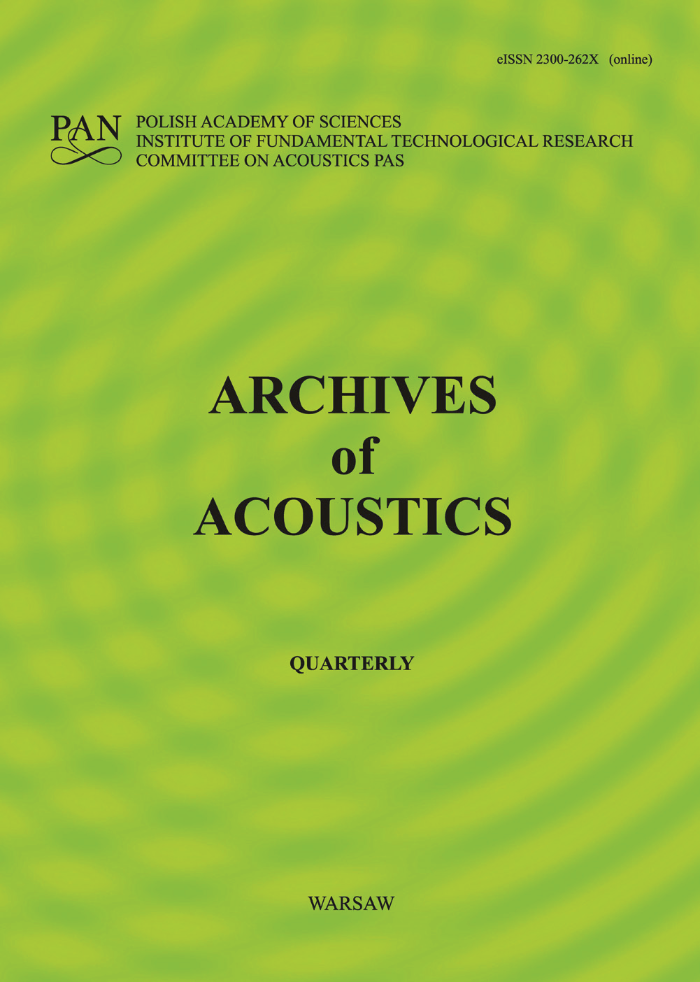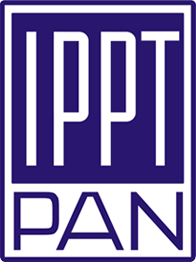Localization of Virtual Sound Source Reproduced by the Crosstalk Cancellation System Under Different Reflective Conditions
Abstract
This study explores the localization of virtual sound source reproduced by the crosstalk cancellation system under different reflective conditions in virtual rooms and analyzes the localization results with binaural cues. Binaural room impulse responses are generated using the high-order image source method. By modifying the acoustic parameters of the virtual room to manipulate the intensity and temporal structure of the reflection, psychoacoustic experiments were conducted using headphone reproduction. The experimental results indicate that, changes in reflection intensity within a certain range by altering the room reverberation time (RT) do not cause noticeable variations in virtual source localization. Increasing the loudspeaker–listener distance (changing temporal structure of reflections) deteriorates localization performance. The primary distinction between variations in the loudspeaker–listener distance and RT lies in whether the temporal structure of the reflection component changes. Overall, the study highlights the importance of the reflection temporal structure in the virtual source localization. The analysis of binaural cues indicates that, even in reverberant environments, the interaural time difference exhibits greater consistency with localization than the interaural level difference.
Keywords:
sound localization, crosstalk cancellation, reflection environment, binaural cuesReferences
- Allen J.B., Berkley D.A. (1979), Image method for efficiently simulating small-room acoustics, The Journal of the Acoustical Society of America, 65: 943–950, https://doi.org/10.1121/1.382599.
- Bahri K. (2019), Loudspeaker directivity and playback environment in acoustic crosstalk cancelation, Msc. Thesis, Charles University of Technology, Gothenburg.
- Bilsen F.A. (1973), Spectral dominance in binaural lateralization, Acustica, 28: 131–132.
- Blauert J. (1997), Spatial Hearing: The Psychophysics of Human Sound Localization, 2nd. ed., The MIT Press, Harvard MA.
- Braasch J. (2013), A precedence effect model to simulate localization dominance using an adaptive, stimulus parameter-based inhibition process, The Journal of the Acoustical Society of America, 134: 420–435, https://doi.org/10.1121/1.4807829.
- Brown A.D., Stecker G.C., Tollin D.J. (2015), The precedence effect in sound localization, Journal of the Association for Research in Otolaryngology, 16: 1–28, https://doi.org/10.1007/s10162-014-0496-2.
- Cooke M. (2005), Modelling Auditory Processing and Organisation, Cambridge University Press, London.
- Folkerts M.L., Stecker G.C. (2022), Spectral weighting functions for lateralization and localization of complex sound, The Journal of the Acoustical Society of America, 151: 3409–3425, https://doi.org/10.1121/10.0011469.
- Gardner W.G. (1998), 3-D Audio Using Loudspeakers, Springer Science & Business Media.
- Genuit K. (1992), Standardization of binaural measurement technique, Le Journal de Physique IV, 2: 405–407, https://doi.org/10.1051/jp4:1992187.
- Gourevitch B., Brette R. (2012), The impact of early reflections on binaural cues, The Journal of the Acoustical Society of America, 132: 9–27, https://doi.org/10.1121/1.4726052.
- Habets E.A. (2010), Room impulse response generator, Technische Universiteit Eindhoven, Technical Report.
- Hancock K.E., Delgutte B. (2004), A physiologically based model of interaural time difference discrimination, Journal of Neuroscience, 24: 7110–7117, https://doi.org/10.1523/JNEUROSCI.0762-04.2004.
- Hartmann W.M. (1983), Localization of sound in rooms, The Journal of the Acoustical Society of America, 74: 1380–1391, https://doi.org/10.1121/1.390163.
- Katz B.F. (2001), Boundary element method calculation of individual head-related transfer function. I. Rigid model calculation, The Journal of the Acoustical Society of America, 110: 2440–2448, https://doi.org/10.1121/1.1412440.
- Kirkeby O., Nelson P.A. (1999), Digital filter design for inversion problems in sound reproduction, Journal of the Audio Engineering Society, 47(7/8): 583–595.
- Kosmidis D., Lacouture-Parodi Y., Habets E.A. (2014), The influence of low order reflections on the interaural time differences in crosstalk cancellation systems, [in:] 2014 IEEE International Conference on Acoustics, Speech and Signal Processing (ICASSP), pp. 2873–2877, https://doi.org/10.1109/ICASSP.2014.6854125.
- Lehnert H., Blauert J. (1992), Principles of binaural room simulation, Applied Acoustics, 36(3–4): 259–291, https://doi.org/10.1016/0003-682X(92)90049-X.
- Lentz T. (2008), Binaural technology for virtual reality, Journal of the Audio Engineering Society, 124(6): 3358–3359, https://doi.org/10.1121/1.3020604.
- Li S., Peissig J. (2020), Measurement of head-related transfer functions: A review, Applied Sciences, 10(14): 5014, https://doi.org/10.3390/app10145014.
- Martin K.D. (1997), Echo suppression in a computational model of the precedence effect, [in:] Proceedings of 1997 Workshop on Applications of Signal Processing to Audio and Acoustics, https://doi.org/10.1109/ASPAA.1997.625622.
- Masiero B., Fels J., Vorländer M. (2011), Review of the crosstalk cancellation filter technique, [in:] Proceedings of ICSA 2011.
- Morimoto M., Iida K. (1995), A practical evaluation method of auditory source width in concert halls, Journal of the Acoustical Society of Japan (E), 16(2): 59–69, https://doi.org/10.1250/ast.16.59.
- Moller H. (1992), Fundamentals of binaural technology, Applied Acoustics, 36(3–4): 171–218, https://doi.org/10.1016/0003-682X(92)90046-U.
- Nowoświat A., Olechowska M. (2022), Experimental validation of the model of reverberation time prediction in a room, Buildings, 12(3): 347, https://doi.org/10.3390/buildings12030347.
- Ocheltree K.B., Frizzel L.A. (1989), Sound field calculation for rectangular sources, IEEE Transactions on Ultrasonics, Ferroelectrics, and Frequency Control, 36(2): 242–248, https://doi.org/10.1109/58.19157.
- Rakerd B., Hartmann W.M. (2010), Localization of sound in rooms. V. Binaural coherence and human sensitivity to interaural time differences in noise, The Journal of the Acoustical Society of America, 128(5): 3052–3063, https://doi.org/10.1121/1.3493447.
- Raatgever J. (1980), On the binaural processing of stimuli with different interaural phase relations, Ph.D. Thesis, Technische Universiteit Delft, Netherlands.
- Rui Y., Yu G., Xie B., Liu Y. (2013), Calculation of individualized near-field head-related transfer function database using boundary element method, Presented at the Audio Engineering Society Convention, paper 8901.
- Rychtáriková M., van den Bogaert T., Vermeir G., Wouters J. (2009), Binaural sound source localization in real and virtual rooms, Journal of the Audio Engineering Society, 57: 205–220.
- Rychtáriková M., van den Bogaert T., Vermeir G., Wouters J. (2011), Perceptual validation of virtual room acoustics: Sound localisation and speech understanding, Applied Acoustics, 72(4): 196–204, https://doi.org/10.1016/j.apacoust.2010.11.012.
- Sabo A. (1999), Effect of early reflections in binaural systems with loudspeaker reproduction, Presented at the IEEE Workshop on Applications of Signal Processing to Audio and Acoustics, pp. 552–556, New York.
- Sabo A. (2001), Influence of reflections on crosstalk cancelled playback of binaural sound, Ph.D. Thesis, Norwegian University of Science and Technology, Trondheim.
- Shinn-Cunningham B., Kawakyu K. (2003), Neural representation of source direction in reverberant space, [in:] 2003 IEEE Workshop on Applications of Signal Processing to Audio and Acoustics (IEEE Cat. No.03TH8684), pp. 79–82, https://doi.org/10.1109/ASPAA.2003.1285824.
- Shinn-Cunningham B.G., Kopco N., Martin T.J. (2005), Localizing nearby sound sources in a classroom: Binaural room impulse responses, The Journal of the Acoustical Society of America, 117(5): 3100–3115, https://doi.org/10.1121/1.1872572.
- Slaney M. (1993), An efficient implementation of the Patterson–Holdsworth auditory filter bank, Apple Computer Technical Report #35, Perception Group – Advanced Technology Group.
- Stern R.M., Zeiberg A.S., Trahiotis C. (1988), Lateralization of complex binaural stimuli: A weighted-image model, The Journal of the Acoustical Society of America, 84(1): 156–165, https://doi.org/10.1121/1.396982.
- Tan W., Yu G., Rao D. (2023), Influence of first-order lateral reflections on the localization of virtual source reproduced by crosstalk cancellation system, Applied Acoustics, 202: 109165, https://doi.org/10.1016/j.apacoust.2022.109165.
- Tollin D.J., Henning G.B. (1998), Some aspects of the lateralization of echoed sound in man. I. The classical interaural-delay based precedence effect, The Journal of the Acoustical Society of America, 104(5): 3030–3038, https://doi.org/10.1121/1.423884.
- Villegas J. (2015), Locating virtual sound sources at arbitrary distances in real-time binaural reproduction, Virtual Reality, 19: 201–212, https://doi.org/10.1007/s10055-015-0278-0.
- Visentin C., Prodi N., Valeau V., Picaut J. (2013), A numerical and experimental validation of the room acoustics diffusion theory inside long rooms, [in:] Proceedings of Meetings on Acoustics, 19(1): 015024, https://doi.org/10.1121/1.4798976.
- Xia J., Shinn-Cunningham B. (2011), Isolating mechanisms that influence measures of the precedence effect: Theoretical predictions and behavioral tests, The Journal of the Acoustical Society of America, 130(2): 866–882, https://doi.org/10.1121/1.3605549.
- Xie B. (2013), Head-Related Transfer Function and Virtual Auditory Display, 2nd ed., J. Ross Publishing.
- Yost W.A., Gourevitch G. (1987), Directional Hearing, Springer.
- Ziegelwanger H., Kreuzer W., Majdak P. (2015), Mesh2HRTF: An open-source software package for the numerical calculation of head-related transfer functions, Presented at the 22nd International Congress on Sound and Vibration, https://doi.org/10.13140/RG.2.1.1707.1128.
- Zwislocki J., Feldman R.S. (1956), Just noticeable differences in dichotic phase, The Journal of the Acoustical Society of America, 28(5): 860–864, https://doi.org/10.1121/1.1908495.







